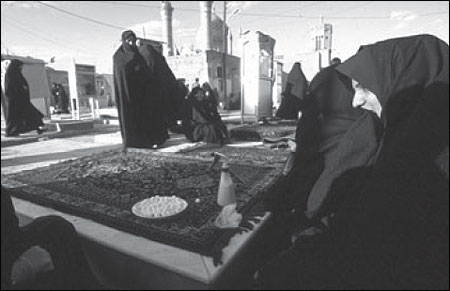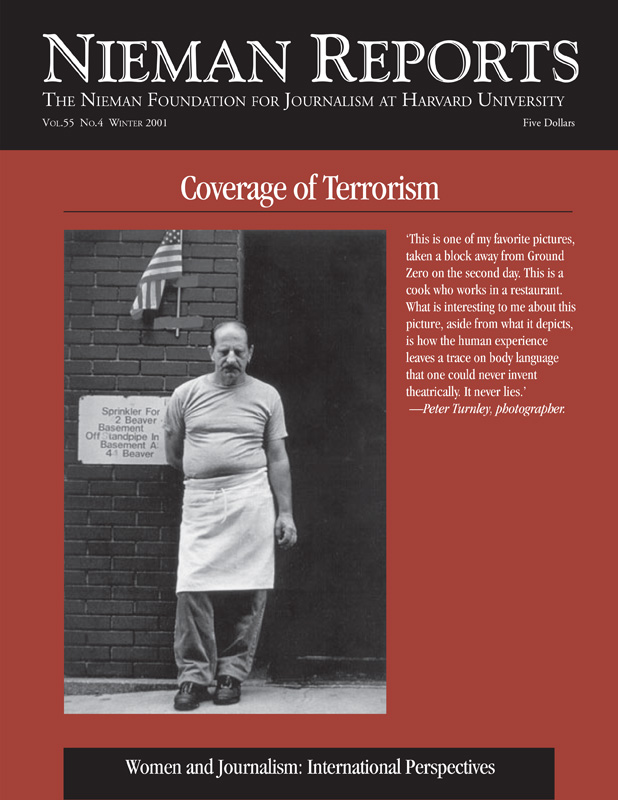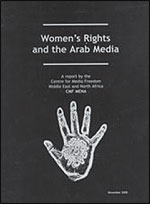
“In Iran, people have the habit of visiting their deceased relatives on Thursday nights. Then they sit on the graves, eat together, read the Koran, talk about their dead relatives, show pictures or share their food and sweets with other visitors. It is like a big family gathering of the living and the dead.”—Katharina Eglau. Photo by Katharina Eglau.©
What is the point of drawing up policies to make women’s rights central to national development when, at the same time, negative stereotyping of women goes on daily in the national press and on television?
Women’s rights campaigners in several Arab countries are organizing today to end this anomaly. They are exposing the negative aspects of media messages and working to overcome the hurdles facing women journalists and to empower them to counter the negativity. A multiplicity of deterrents means the campaign has to take place on several fronts.
Paradoxically, as I realized while researching a report on women in the Arab media for a media freedom center in London, the challenge facing women has become more daunting as the number of Arabic-language media outlets has increased. A popular perception has arisen in recent years that women are everywhere in the Arabic-language media, above all as glamorous news presenters on satellite television channels. The proliferation of Arab-owned satellite channels has also generated an increase in airtime for advertising, with commercials featuring women in large numbers mainly as impressionable consumers, decorative objects or cleaners and cooks. Indeed, in terms of both numbers and images, it seems that women’s growing presence on Arab television, far from ending their subordination in the media, might be reinforcing it.
Evidence collected by Lebanese reporter May Elian and others supports this concern. It suggests that women are used by the appearance-conscious visual media to attract viewers. Worse still, they are used in a way that associates women with a superficial role, in the sense of reading from other people’s scripts or delivering “just one question” reports.
Print journalism, in contrast, is still seen as a male domain because it involves “hard work” and needs to be “taken seriously.” Elian presented comparative data to a seminar on Gender and Communication Policy held in Beirut in the run-up to the U.N. Assembly’s Special Session on Women in 2000. She found that, whereas the dominant Lebanese television stations have many more women than men on their news desks, the gender ratio on newspapers is quite the reverse. Women media professionals surveyed by the Beirut-based Institute for Women’s Studies in the Arab World concurred that important editorial decisions in all media were still invariably made by men.
Hurdles confronting women in the media workplace are universal, as the RELATED ARTICLE
"Arab Women Media Center"International Women’s Media Foundation has shown. The main ones are juggling family obligations with erratic work schedules dictated by breaking news, together with a lack of successful role models. Nagwa Kamel, a Cairo University professor, told the opening conference of the Arab Women Media Center in Amman in June 2001 that media women in the Arab world face several other hurdles as well.
In Arab countries, where heavy media censorship puts publishable news stories at a premium, the best route to obtaining information is through the shilla, or friendship clique. Given the dearth of female ministers, lawyers or other highly placed female sources, the clique, whose members include representatives of the ruling establishment, is bound under current circumstances to be almost exclusively male. Thus a vicious circle is created, in which young women entering journalism are assigned to slow-moving coverage of the three “f’s”—food, family and fashion. Since recognition in this field is hard to come by, training and promotion go to other staff and discouragement sets in.
Mundane explanations such as these for women failing to reach the upper ranks of media firms do not make headlines. Yet they do describe cycles that can be broken and challenges that can be overcome. The risk is that they will be overlooked when more violent (and, under current news values, more newsworthy) reasons are also valid. Examples of the latter include the brutal killings of women journalists during the civil conflict in Algeria and the assassination in March 2001 of Kuwait’s prominent woman publisher and women’s rights activist, Hidaya Sultan al-Salem.
Given obstacles such as these, one potentially positive outcome of reporting on women’s status in the Arab media can be to highlight successful local initiatives that lend themselves to replication elsewhere. Palestinian women in particular have been proactive on this front. Having long played a central role in resisting occupation of their land, Palestinian women started worrying a decade ago that limited self-rule in the West Bank and Gaza would mean reoccupation of public space by patriarchal traditions.
In 1992 they formed a coalition of ideologically disparate groups with a small secretariat and a shared agenda of equal rights for women. Preparations for legislative elections provided a fertile environment in which to combine media and advocacy work. The coalition gained a foothold across the Palestinian media, guaranteeing women a voice on the full range of issues through regular radio and television programs and a newspaper supplement of interest to both women and men.
Another kind of initiative has come from Jordan. Because credible investigative journalism is rare in the Arab world, the work of Jordanian crime reporter Rana Husseini in exposing “honor” crimes against women was newsworthy in itself. Honor crimes involve the murder or attempted murder of women alleged to have besmirched the family’s reputation; they are treated leniently under the laws of Jordan and most other Arab states.
Husseini’s perseverance took her to distant police stations and hospitals and furnished the information on which efforts to amend the discriminatory article of the Jordanian Penal Code could be based. While Husseini’s high profile as a woman in the Jordanian media was not unusual, the nature of her reporting broke through several barriers.
Traditional attitudes in Jordan disapprove of women traveling the country unaccompanied or questioning authority. At the same time, news stories about honor killings brought private family taboos into the public sphere and punctured national complacency about women’s well being. They also involved coverage of court cases at a time when Jordan’s 1998 press law had made such coverage technically illegal.
As these barriers suggest, women in the Arab media not only face obstacles based on gender but are also subject to government-prescribed limitations on freedom of expression. Tunisia is a country which has a long tradition of recognizing women’s legal rights. That did not stop the Tunisian authorities from jailing Sihem Bensedrine, editor of an Internet magazine called Kalima, after she criticized Tunisia’s human rights record during a satellite television program broadcast from London in June 2001.
Amal Abbas, editor in chief of the Sudanese newspaper Al-Rai al-Akher, withstood fines and jail terms in order to expose corruption among officials in Sudan. Al-Rai al-Akher has been subject to seizure and suspension by the Sudanese authorities for several years, demonstrating that female journalists who seek to practice their profession honorably risk losing the platform from which to speak out. Being a woman reporter is one challenge. Producing a newspaper in the face of harsh censorship is another.
Another challenge is promoting the kind of environment in which women not only write and broadcast, and do so freely, but also vote and stand for public office. In Egypt, for instance, women make up an estimated 40 percent of journalists. Yet their number in parliament is under two percent, while less than 10 percent of Egyptian women are registered to vote.
Veteran journalist Amina Shafik of Egypt’s leading government-owned daily, Al-Ahram, once headed her country’s journalists’ union. She and her colleagues say women’s status inside and outside the media has regressed severely in the last 20 years. Concerned at the way women were being squeezed out of public life by fundamentalist misogyny and government apathy, Shafik formed a group called HODA (after the 1920’s feminist Hoda Shaarawi), dedicated to helping local women overcome the cultural and bureaucratic hurdles that deter them from registering to vote.
Unfortunately, civil society groups working for democracy are highly vulnerable in Egypt, as demonstrated when the independent Ibn Khaldun Centre in Cairo, which provided logistical support to HODA and other women’s programs, was closed by the government in the summer of 2000. A year later the Ibn Khaldun Centre’s director, sociology professor and democracy campaigner Saad Eddin Ibrahim, received a seven-year prison sentence in a trial that international human rights monitors unanimously denounced as being unfair.
Initiatives like those mentioned in this article confirm that proactive women executives in the Arab media could help to disseminate positive images of women. In doing so they would respond to society’s wider development needs. But attempts to translate this recognition into action have too often foundered because they require more freedom of expression than governments will allow.
Naomi Sakr has covered the Arab world—as a journalist, editor and country analyst—for more than 25 years. She now specializes in media development as a researcher and lecturer at the University of Westminster and consultant to several non-governmental organizations. The report mentioned in this article, “Women’s Rights and the Arab Media,” was compiled for the Centre for Media Freedom: Middle East and North Africa and published in November 2000. It is available through the Centre for Media Freedom, based in London.




